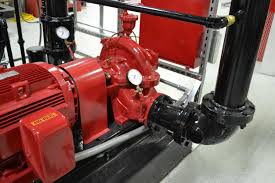Choosing the right fire fighting pump for your home can be challenging, especially with the unique conditions in Australia. An electric fire fighting pump in AU offers a reliable solution for those residing in bushfire-prone areas. These pumps provide basic protection by maintaining water pressure during emergencies. For residential use, electric fire fighting pumps are among the best options due to their efficiency and ease of use.

When selecting a pump, it’s important to consider water pressure and durability, as these factors guarantee the pump performs effectively in emergencies. High-pressure fire pumps can be a great choice, offering the power needed to protect your home. You can find various options for high-pressure fire fighting pumps across different platforms, helping homeowners like you to make informed decisions.
Investing in the right equipment can make a big difference in safeguarding your property and loved ones. For example, in fire-prone areas of Australia, the use of some options, such as electric fire fighting pump in AU is becoming increasingly common, providing more efficient and reliable protection compared to traditional methods. Similar technologies are helping communities manage wildfire risks with greater precision and speed in places like the United States and parts of Europe. As climate change intensifies fire seasons worldwide, upgrading to modern fire safety equipment can significantly enhance both public safety and property resilience.
Understanding Electric Fire Fighting Pumps
Electric fire fighting pumps are necessary safety equipment used to maintain water pressure and suppress fires. They are popular in residential settings for their ease of use and reliability. This section explores the different types of electric fire pumps, their key features, and the regulatory standards they must meet in Australia.
Types of Electric Fire Fighting Pumps
Electric fire fighting pumps come in various types based on design and application. The most common types include centrifugal pumps and positive displacement pumps.
Centrifugal pumps use a rotating impeller to generate water flow and are well-suited for continuous use. They are efficient for large volumes of water at moderate pressure, making them ideal for most residential needs. Positive displacement pumps, meanwhile, move a fixed amount of water per cycle. They are more effective at maintaining a consistent flow in systems requiring precise control.
Key Features and Specifications
When choosing an electric fire fighting pump, there are important features and specifications you should consider. Flow rate, measured in liters per minute (LPM), indicates how much water the pump can deliver. Pressure rating, usually listed in pounds per square inch (PSI), shows the maximum pressure the pump can handle.
Look for pumps with automatic start/stop functions to guarantee seamless operation during emergencies. Noise levels are also important if the pump is near living areas. Additionally, energy efficiency can play a role in keeping operational costs low over time. Be sure to check the size and weight of the pump to match your available space and installation needs.
Regulatory Standards in Australia
In Australia, electric fire fighting pumps must adhere to strict regulatory standards to guarantee safety and effectiveness. Compliance with the Australian Standard AS 2941 is important, as it specifies the requirements for the design, installation, and commissioning of fixed fire pump systems.
These standards guarantee that pumps are tested for performance and safety, providing peace of mind that the equipment will function properly during a fire emergency. It’s important that you verify your pump meets these standards before purchasing, as compliance is necessary for both residential and commercial applications.
Selecting the Best Electric Fire Fighting Pump
Choosing an electric fire fighting pump involves considering residential needs, evaluating top brands and models, and understanding installation and maintenance. Knowing these elements helps match the right pump to your home’s requirements.
Assessing Residential Needs
To start, think about your home’s size and the water supply. A smaller house might require a pump with a lower flow rate, while a larger home may need one that can push out more water per minute. Calculate the distance water needs to travel, as longer distances could mean needing more pressure. Also, check the local fire codes to make sure any pump you consider meets regulations. It’s important to balance pressure and flow to protect your home effectively.
Top Electric Pump Brands and Models
Some popular models offer features suited for residential fire fighting. Look for pumps with a high flow rate and adjustable pressure. Pay attention to the materials used, such as corrosion-resistant components, which can increase a pump’s lifespan. Noise levels can also be a consideration if the pump will be used frequently. Compare various models to see which features match your needs best (2024). Look for availability on large retail platforms for easier purchase options.
Installation and Maintenance Considerations
Proper installation is key to the pump’s performance. Guarantee the location has adequate protection from the elements, like rain or snow, to prevent damage. Regular maintenance is necessary, including checking seals, hoses, and electrical components. Schedule checks before peak fire seasons. Many pumps come with user-friendly manuals, making it easier to follow maintenance steps. Keep spare parts handy so small repairs can keep your pump in working order without delays.
Conclusion
Choosing an electric fire fighting pump for residential use in Australia involves considering a few key factors. You should evaluate the pump’s power source reliability and its ability to provide sufficient water pressure and flow rate during emergencies.
List the specific requirements, such as noise level preference and power supply stability. These considerations can greatly influence which pump is best for your situation.
An electric fire pump suits urban areas with a stable power supply. Their quieter operation can be beneficial in communities where noise is a concern. Make sure your chosen pump meets local safety standards and installation guidelines.
Always have your pump installed by a professional to guarantee it works correctly when needed. Regular maintenance checks are important to keep your pump in top working condition.



